“Footing is the lowest part of the structure that distributes the load on a larger area to avoid any shear or axial failures of the structure”
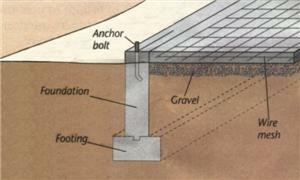 |
| What is foundation? |
Design Criteria of Foundations
For proper transmission of the load the substructures must be designed
• To prevent excessive settlement
• To prevent rotation
• To minimize differential settlement.
In addition, it should be designed in such a way that
• The load bearing capacity of the soil is not exceeded.
• Adequate safety against sliding and overturning is assured.
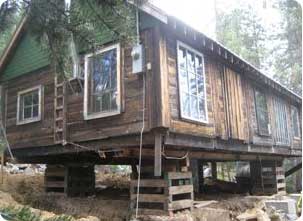 |
| Settlement of Foundation |
Cumulative floor loads of a building, a bridge, or a retaining wall are supported by the foundation substructure in direct contact with soil. The soil underneath the substructure becomes compressed and deformed during its interaction with the substructure.
This deformation is the settlement that may be
• Permanent due to dead loads
• May be elastic due to transition live loads.
The amount of settlement depends on
• Type of soil,
• The load intensity,
• The ground water conditions,
• The depth of the foundation below ground level.
Like Us on Facebook!
Differential Settlement
“If the bearing capacity of the soil is different under the different parts of the foundation of the same structure than differential settlement occurs.”
Subscribe Us on YouTube!
Differential settlement will cause uneven settlement that will overstress the supports of the structural systems.
Due to excessive settlement additional bending and tensional moments in excess of the resisting capacity of members will be produced that would lead to excessive cracking and failures.
If all the building undergoes to even settlement, little or no overstressing occurs.
Types of Foundation
The following are the common type of foundations usually used for a building or structure :-
Isolated Spread Footings
Mostly in a frame structure (having beams and columns) the foundations for a column is isolated or spread footing. These footings are used to carry loads of individual columns. Isolated spread footing may be in any shape like rectangular, square or circular depending upon design requirement.
The footing may be of uniform thickness, stepped, or even have sloped top and reinforced in both directions.
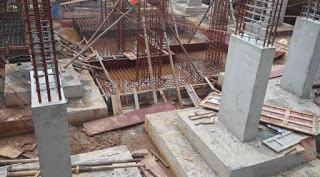 |
| Isolated / Spread Foundation |
These are the most economical type of foundation, when columns are spaced at relatively long distance.
Wall Footings or Strip Footing
Mostly when the walls are load bearing, as in the case of flat plate slab when the slab is directly resting on the walls than the load of such walls is transmitted using wall footing or strip footing. It is in limited width and continuous slab strip along the length of the wall.
“The critical section for bending is located at the face of the wall”
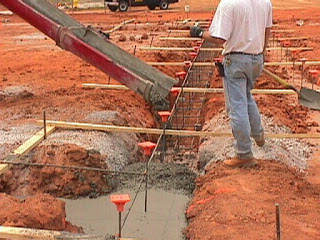 |
| Strip or Wall Foundation |
“The main reinforcement is placed perpendicular to the wall direction”
Wall footings may have uniform thickness, be stepped, or have sloped top.
Combined Footing
In case of closely spaced columns it is more economical to combine their footings in such a way that footings of two or more columns are combined in a rectangular or trapezoidal plan.
The combined footing becomes necessary in situations where a wall column has to be placed on a property line that may be common in urban area. Under such conditions, an isolated footing may not be suitable since it would have to be eccentrically loaded. It is more economical to combine the exterior column footings with an interior column footing.
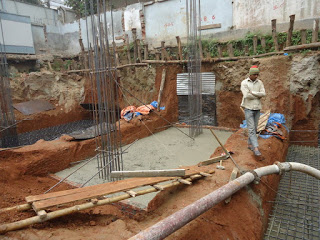 |
| Combined Foundation |
Strap Footing or Cantilever Footing
For eccentric column load at the exterior column (possibly located along the property line) the effect of the bending moment produced is transferred to the interior column footing using a strap beam.
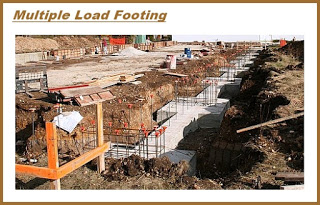 |
| Strap Foundation – Cantilever Foundation |
Mat, Raft or Continuous Footing
In case when the soil conditions are poor and a pile foundation is not economical than the load of the columns is transferred to a mesh or a mat supporting all of the columns.
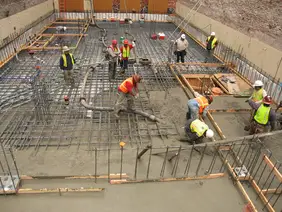 |
| Matt or Raft Foundation |
Pile Foundation
This type of foundation becomes essential when the supporting soil consists of poor layers of material to an extended depth such that an individual or mat foundation is not feasible.
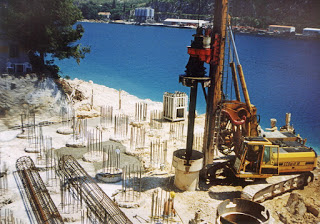 |
| Pile Foundation |
















